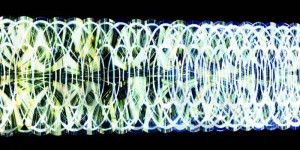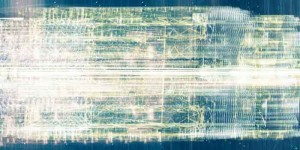The final experiment of my 2007 residency at the Australian Synchrotron developed from several months of discussion with synchrotron accelerator physicists Martin Spencer and Mark Boland about the delicate balance of extremely complex frequencies needed to make a synchrotron beam actually work. This ’synchrotron tune’ as its known in the business, occurs at a frequency of about 13.3 MHz – far outside the range of human hearing – and wondering what this might sound like led me (electronically that is) to Dr Andreas Wilde, at the Fraunhofer-Institut fuer Integrierte Schaltungen Aussenstelle Entwurfsautomatisierung, in Dresden.
Taking advantage of his expertise in acoustic mathematics, we were able to ‘pitch shift’ sound files from the audible ‘spectrum’ up to extremely high frequencies. This allowed me to input a sound into the synchrotron! Via Andreas, I transformed several sounds into data formats that could, literally, be put into the electron beam, however, none seemed right… A chorus of scientists shouting the word ’synchrotron’ (a bit parochial); the ‘Attention! Attention!’ announcement made when an electron injection is about to occur (too self referential); and the opening guitar riff of Fire – a ‘heavy metalesque’ song about particle physics by my old band Crank – which would basically turn the synchrotron into a $200 million effects pedal!
The day before the experiment was due to take place I was stopped in my tracks by the shrill cry of a cicada near the carpark of the facility. The cicada’s deafening, high-pitched tune was not only geo-acoustically appropriate, it also gave me a perfect ’synaesthetic’ picture of the energy beam whirling around the synchrotron ring. I recorded it, sent it to Germany to be encoded and then passed it on to the accelerator physicists.
On the day of the experiment the sound file was ‘pitch shifted’ up from a base frequency of 5 kHz to 1 MHz to make the vibration fast enough to modulate the amplitude of the beam, similar to the way AM radio works. Physicists Mark Boland and Martin Spencer put the data into the control system and tried to oscillate the beam around this frequency. At this point, however, something went wrong and the beam literally failed and stopped. Apparently, I had managed – somewhat impressively – to do what they call ‘dumping the beam’.
Greg LeBlanc, the chief accelerator physicist, even shook my hand and congratulated me on my achievement! But the show went on. They got the beam up and running again, tweaked the data, pitch shifted it higher and even put the maximum energy into the beamline. The data was ‘re-injected’, and this time, success! The cicada frequency was in harmony with the ‘natural’ frequency of the synchrotron beam, and thus the beam vibrated with the sound of the cicada tune. It was a very exciting moment. Even though nothing was directly perceivable, just to know that the heart of the huge and incredibly complex facility around me was pulsating with the sound of the cicada that lived next to it somehow connected the synchrotron back to the world around it. The experiment revealed a relationship between sound and light and energy and matter; the cicada singing in the sunlight and the light in the synchrotron singing with the cicada’s tune. The experiment was a success!
Endnote: As I left the control room a huge storm hit, accompanied by a roar of thunder and flashes of lightning. The wind and rain were ferocious, it was impossible to see outside, the wind blew trees over and water started pouring into the entry foyer and out of the ceiling light fittings. The whole facility had to be shut down. While it’s infinitely unlikely my experiment was the cause, the timing was uncanny. If there can be a ‘butterfly effect’, where a butterfly flapping its wings can in theory affect storms thousands of miles away, perhaps this was the ‘cicada effect’!
Chris Henschke
Chris Henschke is an artist who has been working with digital media since 1987. His main areas of research are in sound and visual relationships, interactivity, and art / science hybridisation. His artworks probe the relationships and tensions between matter and energy, light and sound, observation and theory, information and noise. He was Artist in Residence at the Australian Synchrotron, supported by ANAT and Arts Victoria’s Innovation Residency program from October to December 2007.
Watch More
 This work is licensed under a Creative Commons Attribution-NonCommercial-ShareAlike 2.5 Australia.
This work is licensed under a Creative Commons Attribution-NonCommercial-ShareAlike 2.5 Australia.









[...] See the article ‘The Final Experiment’ in Filter edition 68, Winter 2008, for a description about the ‘tune’ of the Australian [...]